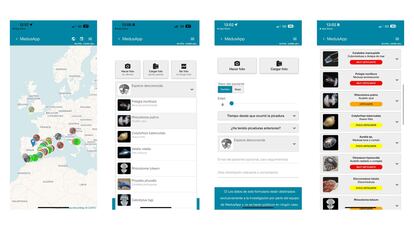Summer is the favorite time for Spaniards to go on vacation, According to Statista. Sun and beach trips are the preferred option for domestic travelers, as indicated a 2024 report from the National Observatory of Outbound Tourism (ObservaTUR). Exist apps These are particularly useful for those who choose this plan. While some indicate the hours when it is advisable to apply sunscreen or wear sunglasses, others alert in real time about the presence of jellyfish on beaches or serve to locate nearby beaches according to the user’s preferences.
A warning to know when to put on sunscreen or sunglasses
Most types of skin cancer are caused by excessive exposure to ultraviolet rays, As indicated by the American Cancer SocietySunSmart Global UV is a tool to protect you from the dangers of sun exposure. The app is based on the UV Index, which describes the level of ultraviolet radiation from the sun on the Earth’s surface. The UV Index is presented on a scale from 1 (“low level”) to 11 or more (“extreme level”). “The higher the index value, the greater the potential for causing damage to the skin and eyes, and the less time it takes for that damage to occur,” says the World Health Organization (WHO).
After downloading it, the user must indicate where they are. The app then indicates at what time it is advisable to apply sunscreen, wear loose clothing that covers most of the skin, put on a hat or sunglasses or seek shade. This is something that it recommends doing, for example, on a sunny day of 29 degrees in Madrid between 10 and 10 in the morning and 6 and 10 in the evening. The user can activate an alert so that the application warns them when they have to take these measures. One strong point of this app is that the user can activate an alert so that the application warns them when they have to take these measures. app It was developed with the help of the WHO, the World Meteorological Organization (WMO) and the United Nations Environment Programme (UNEP).
A magnifying glass to apply sunscreen correctly
“Did you know there is a trick to avoid getting sunburned again when you go to the beach?” says an Instagram userIf you go into the magnifying glass app and put the filter on inverted, you can see which part of your body you haven’t put sunscreen on. It is also possible to use the Instagram “inverted” filterThis trick works with white and yellowish creams and is especially useful for those who tend to leave unprotected areas when applying sunscreen.
A map to find out if there are jellyfish on the beach
There are about 10,000 species of jellyfish. Of these, about 100 are dangerous to humans, According to several investigations. In MedusApp, users themselves report the presence of jellyfish on a particular beach. They can report if there are “no jellyfish in sight”, if they have seen any in the sea or stranded on the beach (if they know, they can indicate what species it is) and even if they have suffered a sting.
“Although we prefer a photo to give greater validity to the sighting, you can also report it without a photo, in case you saw them swimming or diving without a camera or mobile phone on you,” say the creators of the app, which compiles all this information on a map. MedusApp also offers information about the different types of jellyfish and what to do if you suffer a sting.

Apps to find out if there will be waves or the water temperature
“The Spanish and Portuguese coastlines have almost 4,300 beaches, including some real gems,” say the creators of iPlaya. This application, available for iPhone, allows you to consult free, detailed, real-time information about a specific beach. For example, weather conditions, tide data, and sunrise and sunset times. There is a paid version for two euros per month that offers additional information, such as ultraviolet indices, tide forecasts for the next 15 days, topographic maps of the area, and exclusive drone videos of the beaches.
Another useful app for users of mobile phones with the iOS and Android operating systems is iMar. When downloading this application developed by Puertos del Estado, you can choose whether you prefer a simple or advanced profile. Both are free, but the second offers additional tables and graphs for those more knowledgeable in the field. The user can consult all kinds of information about a beach in real time: air temperature, atmospheric pressure, wind speed, whether there are waves, water temperature or sea level. You also have access to forecasts for the next few days. Both iPlaya and iMar include maps that can help users find beaches on the Spanish coast.

You can follow THE COUNTRY Technology in Facebook and X or sign up here to receive our weekly newsletter.




